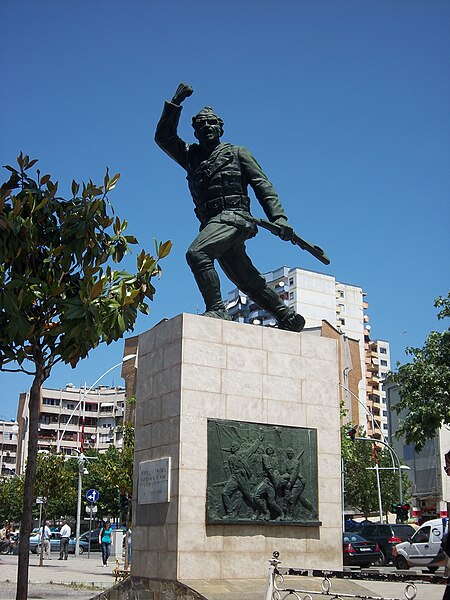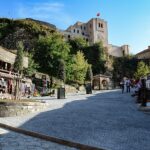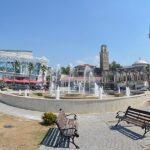Vorë is a small town located in central Albania, known for its beautiful natural surroundings and historical landmarks. Here are some of the best places to visit and things to do in Vorë:
1. Skanderbeg Square

Image Source: https://en.wikipedia.org/wiki/Skanderbeg_Square
This stunning natural park offers hiking trails through dense forests, rocky terrain, and stunning views of the surrounding landscape. It’s a great place to connect with nature and get some exercise.
2. Et’hem Bey Mosque:

Image Source: https://en.wikipedia.org/wiki/Et%27hem_Bey_Mosque
The Et’hem Bey Mosque is a beautiful example of Ottoman-era architecture and a must-visit for anyone interested in history or architecture. It is one of the oldest and most beautiful mosques in the city and an important symbol of Albania’s Islamic heritage.
3. Petrela Castle
Image Source: https://en.wikipedia.org/wiki/Petrel%C3%AB_Castle
This medieval castle is located just a short distance from Vorë and offers a glimpse into Albania’s rich history. Visitors can explore the castle and learn about its strategic importance during the Ottoman period.
4. Enver Hoxha Pyramid
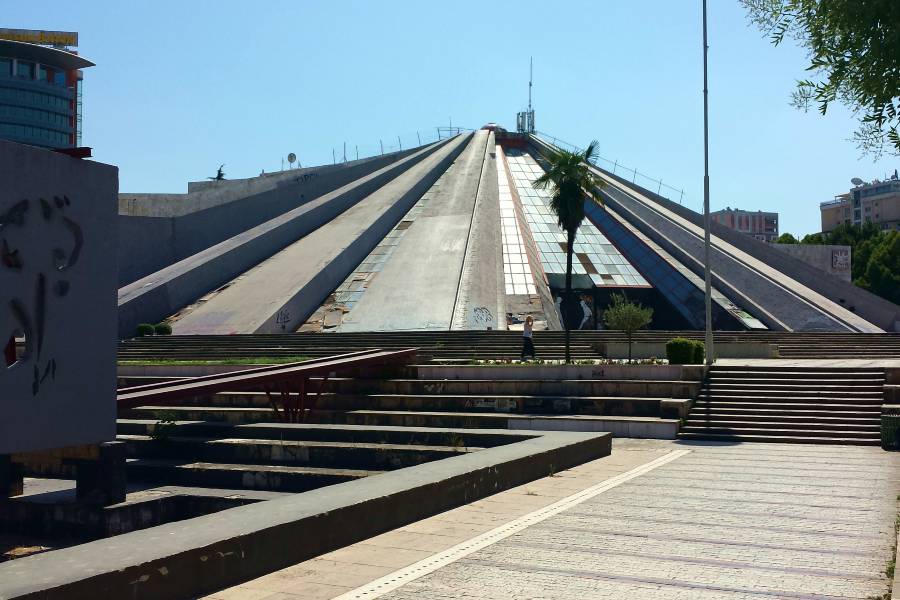
Image Source: https://us.trip.com/travel-guide/attraction/tirana/tirana-e-re-piramida-18694973/
The “Tirana e Re” Pyramid, also known as the Enver Hoxha Pyramid or simply the Pyramid, is a unique architectural landmark. The Pyramid stands at 17,000 square meters and was built with a concrete and steel frame, covered with marble panels. The building was designed to be an imposing and monumental structure, meant to symbolize Hoxha’s strength and leadership.
5. Preza Castle

Image Source: https://en.wikipedia.org/wiki/Prez%C3%AB_Castle
Preza Castle, also known as the Preza Fortress, is a medieval castle located in the village of Preza, just a short drive from Vorë, in central Albania. The castle dates back to the 14th century and was originally built by the Balsha family, a powerful feudal clan that ruled over much of central Albania during the medieval period. Over the centuries, the castle was destroyed and rebuilt several times, and it played a significant role in the region’s history.
6. Castle of Kruja
Image Source: https://en.wikipedia.org/wiki/Castle_of_Kruj%C3%AB
The castle dates back to the 5th century and played an important role in the country’s history, particularly during the 15th century when it was the center of resistance against the Ottoman invasion. The castle was the stronghold of the Albanian national hero, Skanderbeg, who led the resistance against the Ottoman Empire for more than 20 years.
7. Amphitheatre of Durrës
Image Source: https://en.wikipedia.org/wiki/Amphitheatre_of_Durr%C3%ABs
Amphitheatre of Durrës is a popular tourist destination, attracting visitors from all over the world who come to admire its impressive architecture and learn about its rich history. Visitors can explore the amphitheater’s many rooms and galleries, which house a variety of historical artifacts and exhibits, including ancient Roman pottery, coins, and other relics.
8. Resurrection of Christ Orthodox Cathedral

The Orthodox Church in Albania has a long and rich history that dates back to the earliest days of Christianity in the country. In the Middle Ages, the Orthodox Church played an important role in the country’s cultural and political life, and it was a center of resistance against Ottoman rule in the 15th and 16th centuries.
9. Saint Paul Cathedral

Image Source: https://en.wikipedia.org/wiki/St_Paul%27s_Cathedral
The Saint Paul Cathedral, also known as Katedralja e Shën Palit in Albanian. It was completed in 2001 and is named after Saint Paul, one of the apostles of Jesus Christ. The Saint Paul Cathedral is an important religious and cultural landmark. It hosts a variety of religious services and events throughout the year, including Masses, baptisms, weddings, and funerals.
10. Clock Tower

Image Source: https://en.wikipedia.org/wiki/Clock_tower
The clock tower was built in the early 19th century by the Ottomans during their rule over Albania. It stands at 35 meters tall and has a clock face on each side of the tower. The clock itself was made in Vienna in 1928 and still works today. The Clock Tower of Tirana is a must-visit destination for anyone traveling to the city. Its beautiful architecture, historic significance, and stunning views make it one of the most popular landmarks.
11. Museum of Secret Surveillance

Image Source: https://en.wikipedia.org/wiki/Museum_of_Secret_Surveillance
The museum is housed in a former government building that was used by the communist secret police, known as the Sigurimi. During the communist era, the building was used for interrogation, torture, and imprisonment of political dissidents and others who were deemed to be enemies of the state. The Museum of Secret Surveillance, also known as the House of Leaves
12. Tanners’ Bridge
Image Source: https://en.wikipedia.org/wiki/Tanners%27_Bridge
The bridge features unique Ottoman-era architecture, with eleven stone arches that support the bridge’s structure. The arches are slightly pointed and have a span of about 8 meters each. The bridge is made of limestone and has been restored several times throughout its history.
13. Postbllok Checkpoint Monument

Image Source: https://www.tripadvisor.in/Attraction_Review-g294446-d12065282-Reviews-Postbllok_Checkpoint_Monument-Tirana_Tirana_County.html
The monument was installed in 1981 and served as a checkpoint where visitors to the city had to show their identification documents and pass through security checks. It was a symbol of the strict control and surveillance that characterized life in Albania during the communist era.
14. Mount Dajti

Image Source: https://en.wikipedia.org/wiki/Dajti
Mount Dajti National Park is home to a wide variety of flora and fauna, including oak and beech trees, wildflowers, and animals such as brown bears, wolves, and lynx. The park is also home to several small villages and traditional Albanian restaurants that serve local cuisine. Mount Dajti offers skiing and snowboarding opportunities, with several ski slopes and resorts in the park. In the summer, visitors can enjoy swimming in the park’s lakes and rivers or relaxing in the shade of the park’s forests.
15. Durres Castle

Image Source: https://en.wikipedia.org/wiki/Durr%C3%ABs_Castle
The castle’s walls are made of large stones and are about 15 meters high. The castle has three main entrances and several watchtowers, which were used to keep a lookout for approaching enemies. Durres Castle is a must-visit destination for anyone interested in history and architecture. It offers a unique opportunity to experience Albania’s rich cultural heritage and explore the country’s ancient past.
16. Unknown Partisan monument
Image Source: https://en.wikipedia.org/wiki/Unknown_Soldier_(statue)
The monument consists of a large rectangular block of concrete with a bronze statue of a Partisan fighter on top. The statue depicts a male Partisan fighter holding a rifle in his hand and wearing a uniform and a cap. The concrete block has the inscription “Lavdi dëshmorëve të kombit” (Glory to the martyrs of the nation) and is surrounded by several smaller stones with the names of the districts where Partisans fought and died during the war.
17. Independence Monument
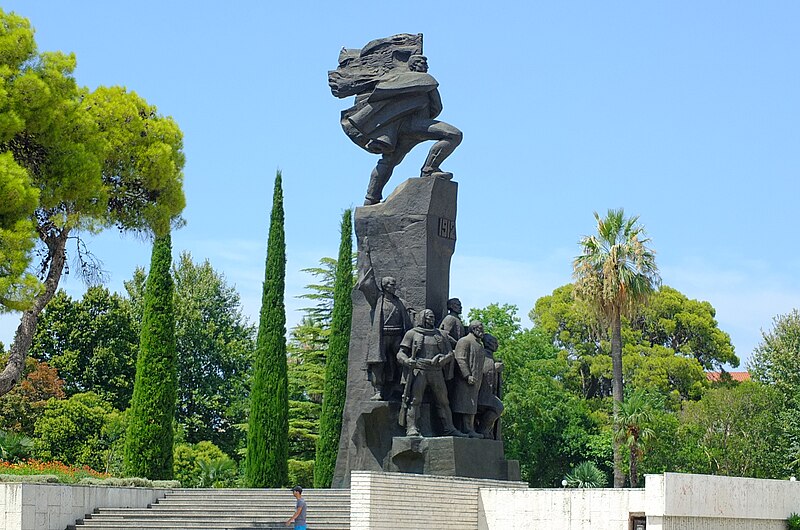
Image Source: https://en.wikipedia.org/wiki/Independence_Monument_(Albania)
The monument is made of concrete and stands 12 meters tall. It consists of a large circle with a map of Albania in the center, surrounded by 28 pillars that represent the country’s districts. The pillars are inscribed with the names of the districts and their dates of liberation from Ottoman rule.
Vorë offers a range of interesting sights and activities for visitors, from beautiful natural scenery to rich cultural heritage. Whether you’re interested in history, nature, or adventure, Vorë is sure to have something to offer.
Places and Things To Do






